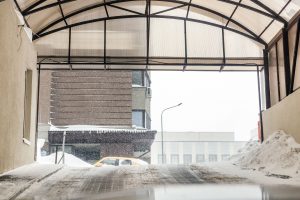Removing Snow From Parking Structures

 Proper removal of snow from a parking garage is usually the first thing on the owner’s mind after a snowstorm to the allow the garage’s top deck to become operational again. However, some owners may not realize that improper removal of the snow could jeopardize their structure, particularly if all the snow is stored on a single location on the top deck. Most buildings within the surrounding area are designed to withstand a code-prescribed snow load of approximately 30 pounds per square foot (psf). However, stacking large amounts of wet, melting snow in a concentrated area can cause loads double or triple the design load to be applied to the structure, risking its structural integrity and, in the worst case scenarios, leading to failure.
Proper removal of snow from a parking garage is usually the first thing on the owner’s mind after a snowstorm to the allow the garage’s top deck to become operational again. However, some owners may not realize that improper removal of the snow could jeopardize their structure, particularly if all the snow is stored on a single location on the top deck. Most buildings within the surrounding area are designed to withstand a code-prescribed snow load of approximately 30 pounds per square foot (psf). However, stacking large amounts of wet, melting snow in a concentrated area can cause loads double or triple the design load to be applied to the structure, risking its structural integrity and, in the worst case scenarios, leading to failure.
There are several more building-friendly ways to remove this snow and get the parking open again. One way to remove the snow would be close the top deck to vehicular traffic until the snow melts; however, given the amount of snow and conditions following the storm, this could take several days. De-icing salts could be used to accelerate the melting of the snow, but if the slab has never received a protective coating, the chloride-heavy melted snow could penetrate into the slab and accelerate deterioration of the steel reinforcement within the slab. If the owner chooses to remove snow off of the top deck through use of shovels and plows, special equipment may need to be used to ensure any coatings on top of the slab are not damaged. Ultimately, the best way to remove snow following a storm depends on the needs and composition of your specific structure.


 When the summer heats up, we often begin looking for methods of keeping things cool while outdoors. Whether we are trying to cool our gardens, our structures, or ourselves, water is considered one of the most effective tools in this regard. But not all things will benefit from added water, even on a hot summer day.
When the summer heats up, we often begin looking for methods of keeping things cool while outdoors. Whether we are trying to cool our gardens, our structures, or ourselves, water is considered one of the most effective tools in this regard. But not all things will benefit from added water, even on a hot summer day.

 We have found paving fabrics to be very useful in pavement rehabilitation. However, it’s important to apply a proper thickness of asphalt over the fabric or premature failures can occur.
We have found paving fabrics to be very useful in pavement rehabilitation. However, it’s important to apply a proper thickness of asphalt over the fabric or premature failures can occur. When evaluating asphalt pavement, including asphalt-paved parking decks, ETC recommends core sampling as part of our investigative service. Extracting a core sample of the pavement can be beneficial in telling the history of the pavement construction as well as the conditions of the sub-base profile beneath the asphalt.
When evaluating asphalt pavement, including asphalt-paved parking decks, ETC recommends core sampling as part of our investigative service. Extracting a core sample of the pavement can be beneficial in telling the history of the pavement construction as well as the conditions of the sub-base profile beneath the asphalt.
 Unfortunately, there isn’t a quick fix for addressing footprints in your
Unfortunately, there isn’t a quick fix for addressing footprints in your 


 Imagine a winter without the need for ice melt. Researchers at Drexel, Purdue and Oregon State University are working with concrete admixtures to hopefully make this a reality. Their research includes the addition of phase changing materials such as paraffin, coconut, or palm oils into the concrete mix and has proven to melt snow in certain conditions. The phase change materials release thermal energy as they solidify, meaning as the temperature drops, they release heat, which melts the snow. The inclusion of the phase changing materials in the concrete mix result in a one-time cost at construction rather than reoccurring costs, such as electricity, in cases where heating elements are embedded in concrete for snow melting. More information on the research can be found at the following link: http://drexel.edu/now/archive/2017/September/self-melting-concrete-roads/.
Imagine a winter without the need for ice melt. Researchers at Drexel, Purdue and Oregon State University are working with concrete admixtures to hopefully make this a reality. Their research includes the addition of phase changing materials such as paraffin, coconut, or palm oils into the concrete mix and has proven to melt snow in certain conditions. The phase change materials release thermal energy as they solidify, meaning as the temperature drops, they release heat, which melts the snow. The inclusion of the phase changing materials in the concrete mix result in a one-time cost at construction rather than reoccurring costs, such as electricity, in cases where heating elements are embedded in concrete for snow melting. More information on the research can be found at the following link: http://drexel.edu/now/archive/2017/September/self-melting-concrete-roads/. Parking garages in this region are attacked by road salts and water throughout much of the year. The cost to repair deteriorated concrete can be quite high and the project can cause significant inconvenience to garage users. So, as part of a parking garage restoration project, we recommend and our clients tend to include, application of a vehicular-traffic-bearing membrane on the structural slabs to help protect their investment and extend the service life of the garage.
Parking garages in this region are attacked by road salts and water throughout much of the year. The cost to repair deteriorated concrete can be quite high and the project can cause significant inconvenience to garage users. So, as part of a parking garage restoration project, we recommend and our clients tend to include, application of a vehicular-traffic-bearing membrane on the structural slabs to help protect their investment and extend the service life of the garage.





 Is your concrete peeling or flaking in localized areas? Are you noticing rough, aggregate surfaces in your concrete that haven’t been there before, particularly after the latest round of winter weather? If so, your concrete may be experiencing a condition called scaling.
Is your concrete peeling or flaking in localized areas? Are you noticing rough, aggregate surfaces in your concrete that haven’t been there before, particularly after the latest round of winter weather? If so, your concrete may be experiencing a condition called scaling.